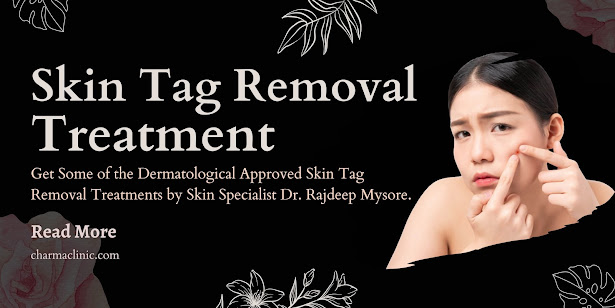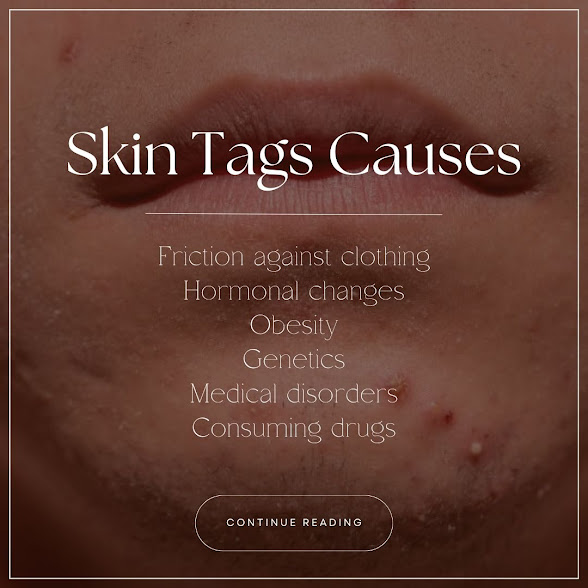Skin tags similar to moles are tiny, benign growths that frequently develop on the surface of the skin. Although there are no health hazards associated with them, many people want to have them removed for comfort or cosmetic reasons. Even if there are many over-the-counter medicines and DIY cures, safety and effectiveness must come first.
This article entails an ultimate guide on the removal of skin tags. This guide details the cause of skin tags and their effective treatments performed by skin experts like Dr. Rajdeep Mysore, the best dermatologist in Bangalore practises at Charma Clinic. So read the post carefully.
What are Skin Tags?
Skin tags are the additional grown soft skin tissues on the skin. These tags are painless, tiny fragments of skin protruding from them on a short stalk or peduncle. These typically show up on the:-
- Upper trunk
- Neck, eyelids
- Body folds
- Armpits
Causes of Skin Tags
Some of the most common reasons for skin tags to form are as follows:
Skin rubbing or friction against clothing or other skin
Hormonal changes, particularly during pregnancy
Obesity or having too much body fat
Skin tag genetics or family history
Age, as skin tags increase in frequency as people get older.
Either insulin resistance or diabetes
Medical disorders, like an infection with the human papillomavirus (HPV),
Some drugs, including steroids
Specific locations of chafing or skin discomfort
Unhygienic conditions in skin folds
Skin tags fueled by the above-mentioned reasons followed by accumulation of collagen and blood vessels in thicker areas of the skin take place.
Even though skin tags are harmless and non-cancerous, the aesthetics concerns for many individuals require effective treatment.
Skin Tag Removal Treatments
To remove the skin tags, some of the dermatological approved treatment for skin tag removal are underneath:
Cryotherapy
Cryotherapy is a non-invasive skin tag removal treatment. This method involves the use of liquid nitrogen to freeze the skin tags. This causes the cells to break down and eventually fall off. To perform the procedure, dermatologists use a specialised device to apply the liquid nitrogen accurately. The procedure is relatively quick and causes minimal discomfort. However, depending upon the tag size, cryotherapy may require multiple sessions for complete removal.
Electro Cauterization
Electro Cauterization also called Electrocautery involves the use of an electric current to burn the skin tag off the skin's surface. Electrocautery effectively seals blood vessels during the process, reducing bleeding. This method is suitable for larger skin tags and is generally quick and safe when performed by a professional.
Ligation
Ligation is the process of cutting off the skin tag's blood supply using a thin surgical thread or suture. This stops the blood supply, causing the skin tag to wither and come off within a few days. Although this technique is straightforward, it must be carried out by a dermatologist to ensure accurate placement and lower the risk of infection.
Excision
Skin care doctor may choose to surgically remove the skin tag. In order to do this, the skin tag must be removed from its base using a scalpel or surgical scissors. To numb the area before the treatment, local anaesthetic is typically used. Larger skin tags respond quickly to excision, which is beneficial in these cases. This may be provided to individuals:
Experiencing the appearance of large or unpleasant skin tags
Skin tags that are bothersome or irritating because of where they are
Skin tags that have been examined by a doctor and are benign
People who are comfortable with a small surgical treatment and seek rapid results
Candidates who are prepared to adhere to post-removal care guidelines in order to promote proper healing
Even while some people might be tempted to try skin tag removal DIY techniques, they are advised against doing so without a skin doctor's advice. Home cures including applying acidic substances, cutting out skin tags with scissors, or tying them off with dental floss might result in infection, scarring, and other problems.
Safety Precautions
Regardless of the removal method, there are essential safety precautions to consider:
Sterilisation: To lower the danger of infection, make sure that all tools used for skin tag removal are adequately sanitised.
Topical Anaesthetic: To reduce pain during electrocautery or excision operations, a dermatologist may employ topical anaesthesia.
After the removal operation: Pay close attention to the aftercare instructions provided by the dermatologist. To do this, candidates might keep the area tidy, refrain from touching it too much, and apply any creams or ointments that have been prescribed.





.jpg)

.jpg)











0 Comments